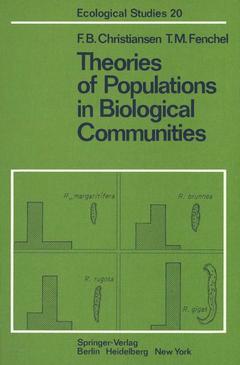Theories of Populations in Biological Communities, Softcover reprint of the original 1st ed. 1977 Coll. Ecological Studies, Vol. 20
Langue : Français
Auteurs : Christiansen F. B., Fenchel T. M.

When we wrote this book it was, admittedly, flrst of all for the sake of our own enjoyment and enlightenment. We will, however, add our sincerely meant (but rather traditional) hope that it will prove interesting to graduate students, to colleagues and to anyone else, who will bother to read it. The book was written as a joint effort by a theoretically inclined population geneticist and an experimental ecologist who share opinions on what is interesting in the fleld of theoretical ecology. While we believe that qualifled natural history is of indisputable intrinsic value, we think that ecology is a natural science which should have a theoretical framework. On the other hand, theoretical ecology must draw its inspiration from nature and yield results which give insight into the flndings of the naturalist and inspire him to make new observations and experiments. Without this relationship between fleld biology and theory, mathe matical ecology may become a discipline totally divorced from biology and solve-albeit interesting-mathematical problems without signiflcance for ecology. Therefore, in addition to theoretical population biology (including some original models) the book also discusses observational data from nature to show how the theoretical models give new insight and how observations give rise to new theoretical thought. While no book on ecology could do without the mention of the hare-lynx example (and ours is, therefore, no exception) we have tried to bring new examples mainly derived from one of the authors' fleld of experience: microbial ecology and marine biology.
1. Population Growth and Fitness.- 1.1 Density-Regulated Population Growth.- 1.2 Genetical Models of Population Growth.- 1.3 Competition and Bacterial Growth in Chemostats.- 1.4 Reproductive Effort of Populations.- 1.5 An Evolutionary Dichotomy.- 2. Interactions Between Species.- 2.1 One-Prey-One-Predator Models.- 2.2 Two Species Competing for Resources.- 2.3 Mutualistic Pairs of Species.- 2.4 Linear Models of Food Webs.- 2.5 Competition Models with Many Species.- 2.6 Simple Food Web Models.- 3. The Niche and Limiting Similarity.- 3.1 The Concept of the Niche.- 3.2 Niche Dimensions.- 3.3 The Formulation of Competition Coefficients.- 3.4 Limiting Similarity.- 3.5 The Evolution of Competing Species.- 3.6 Components of the Niche.- 3.7 Evidence from Nature.- 4. Geographically-Structured Populations and Migration-Extinction Equilibria.- 4.1 Migration Pressure and Competition.- 4.2 Migration Between Identical Habitat Patches.- 4.3 Stochastic Extinction of Populations.- 4.4 Fugitive Equilibria.- 4.5 The Theory of Island Biogeography.- 5. The Concept of Biological Communities.- References.
Date de parution : 01-2012
Ouvrage de 144 p.
17x24.4 cm
Thème de Theories of Populations in Biological Communities :
Mots-clés :
Biological Communities; Communities; Lebensgemeinschaft; Population; Populations; Theories; ecology
© 2024 LAVOISIER S.A.S.



